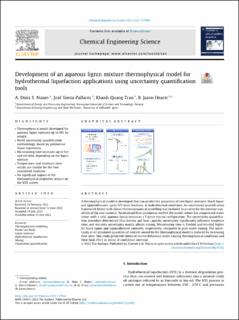| dc.contributor.author | Simões Nunes, Ângelo Dinis | |
| dc.contributor.author | Sierra-Pallaras, José | |
| dc.contributor.author | Tran, Quang Khanh | |
| dc.contributor.author | Hearst, Robert Jason | |
| dc.date.accessioned | 2022-11-08T09:33:55Z | |
| dc.date.available | 2022-11-08T09:33:55Z | |
| dc.date.created | 2022-08-04T12:05:05Z | |
| dc.date.issued | 2022 | |
| dc.identifier.issn | 0009-2509 | |
| dc.identifier.uri | https://hdl.handle.net/11250/3030581 | |
| dc.description.abstract | A thermophysical model is developed that can predict the properties of two lignin mixtures, black liquor and lignosulfonates, up to 50% mass fractions, at hydrothermal conditions. An uncertainty quantification framework linked with classic thermodynamical modelling was included to account for the extreme variability of the raw material. An idealised flow simulation verified the model, where hot compressed water mixes with a cold, aqueous lignin stream in a T-piece reactor configuration. The uncertainty quantification procedure determined that density and heat capacity uncertainty significantly influence residence time, and viscosity uncertainty mainly affects mixing. Micromixing time is fivefold and ten-fold higher for black liquor and lignosulfonates mixtures, respectively, compared to pure water mixing. The uncertainty in all simulated quantities of interest caused by the thermophysical model is reduced by increasing flow rates. This study predicted chemical reactor behaviour under varying thermophysical conditions and their final effect in terms of confidence intervals. | en_US |
| dc.language.iso | eng | en_US |
| dc.publisher | Elsevier | en_US |
| dc.rights | Navngivelse 4.0 Internasjonal | * |
| dc.rights.uri | http://creativecommons.org/licenses/by/4.0/deed.no | * |
| dc.title | Development of an aqueous lignin mixture thermophysical model for hydrothermal liquefaction applications using uncertainty quantification tools | en_US |
| dc.title.alternative | Development of an aqueous lignin mixture thermophysical model for hydrothermal liquefaction applications using uncertainty quantification tools | en_US |
| dc.type | Peer reviewed | en_US |
| dc.type | Journal article | en_US |
| dc.description.version | publishedVersion | en_US |
| dc.source.volume | 261 | en_US |
| dc.source.journal | Chemical Engineering Science (CES) | en_US |
| dc.identifier.doi | 10.1016/j.ces.2022.117944 | |
| dc.identifier.cristin | 2041140 | |
| cristin.ispublished | true | |
| cristin.fulltext | original | |
| cristin.qualitycode | 2 | |

